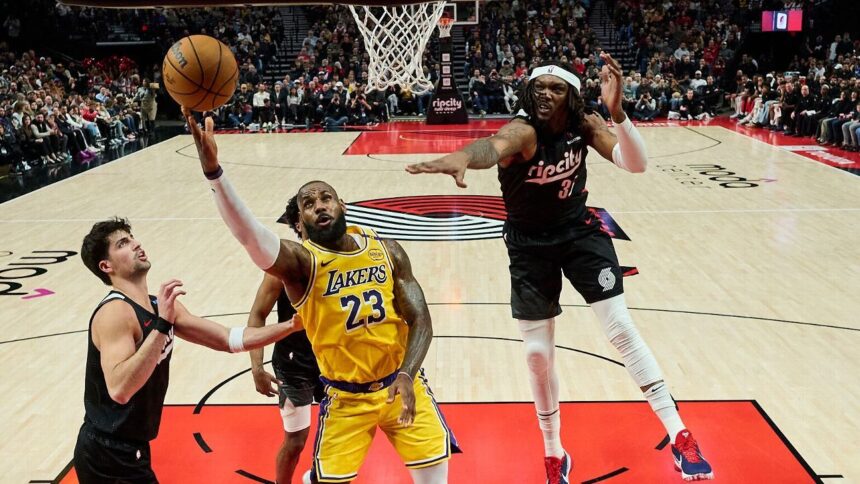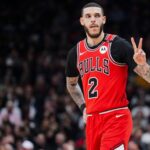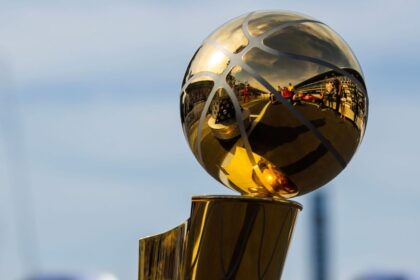With the NBA Draft concluded, the league’s teams turn their attention to free agency and the trade market.
How many teams have available cap space, and which ones could generate it? Which teams are near the first or second “apron” (restrictive salary cap) and face the roster-building limitations that this entails? Who could follow the example of the Boston Celtics and make trades to reduce their luxury tax bill?
We analyze all 30 teams, breaking them down by categories, examining available cap space, key free agents, best fits, and potential moves for each franchise this summer.
Keys: ETO = Early Termination Option | P = Player Option | R = Restricted | T = Team Option
Equipment Categories
- Teams with cap space
- Cap space, but with cost
- The $14.1 million exception club
- Watching their own free agents
- Teams in the first “apron”
- Teams in the second “apron”
Tier 1: Teams with cap space
Currently, only the Brooklyn Nets are projected to generate more than $20 million in salary cap space this offseason. For comparison, last offseason, the Charlotte Hornets, Detroit Pistons, Oklahoma City Thunder, Orlando Magic, Philadelphia 76ers, San Antonio Spurs, and Utah Jazz used the space to improve their rosters or acquire salaries through trades. The scarcity of teams with purchasing power is due to the continuous increase in rookie and veteran extensions signed since last July.
Teams must spend at least 90% of the $154.6 million salary cap before the first day of the regular season. This means that a team like Brooklyn, which has $96 million in salaries, must spend $139.2 million before October 21st. If the Nets do not meet the minimum requirement for the start of the season, the difference will be distributed among their own players. Brooklyn would also lose the end-of-season cash distribution for teams that do not pay taxes, which is projected at $11.7 million. The difference in the amount below the floor also applies to the Nets’ team salary. This means that the maximum salary space the Nets would have in the regular season is $15.5 million.
A team that exceeds the salary cap will also have the $8.8 million mid-level exception to use, either to sign a player or acquire him through a trade once the salary space has been exhausted.
The free agents with cap space mentioned below are players expected to sign contracts for more than $14 million. The designation “player” means that the player can opt for a final year of their current contract.
Brooklyn Nets
Projected space: $35 million
The Nets go from selecting a record five first-round picks to using nearly $45 million in free agency. In addition to prioritizing restricted free agents Cam Thomas and Day’Ron Sharpe, Brooklyn is a destination for teams looking to shed salaries, but with the condition of including draft picks.
Because teams must spend 90% of the salary cap before the first day of the regular season, Brooklyn is expected to be active in free agency, even if the Nets don’t target star players like Kyrie Irving and James Harden. Brooklyn has $96 million in salaries and will need to spend an additional $44 million.
Team needs: Lead facilitator and overall depth
Free agents who fit: Josh Giddey, Julius Randle, Tyus Jones, Jonathan Kuminga, Thomas, D’Angelo Russell, Malik Beasley, Malcolm Brogdon, Caris LeVert, Precious Achiuwa, Davion Mitchell, Quentin Grimes, and Oscar Tshiebwe
Moves I would make: With the available salary space, I would sign restricted free agent center Santi Aldama to a two-year, $40 million offer. Then, I would re-sign Thomas to a three-year, $54 million contract. Even with the addition of rookies Egor Demin and Nolan Traore, re-signing Thomas should be prioritized.
Under contract: Nicolas Claxton, Cameron Johnson, Terance Mann, Noah Clowney, Dariq Whitehead, Keon Johnson (T), Jalen Wilson (T), Tyrese Martin (T), Drew Timme (T), Egor Demin, Nolan Traore, Drake Powell, Ben Saraf and Danny Wolf.
Key free agents: Thomas (R), Sharpe (R)
Other free agents: Johnson, Wilson, Martin, Timme, Russell, De’Anthony Melton, Trendon Watford, Ziaire Williams
Tier 2: Salary space, but with cost
The Pistons and Grizzlies could join Brooklyn in the first tier, but at the cost of renouncing their own free agents or making a trade. Memphis is practically assured to create cap space and then renegotiate and extend Jaren Jackson Jr.’s contract.
Detroit Pistons
Projected space: To be determined
The ability to generate up to $17 million in salary space has significant implications for the Pistons’ roster. If Detroit decides to use that space, it would need to renounce free agents Malik Beasley, Tim Hardaway Jr., and Dennis Schroder. Beasley could be signed with that space, and Detroit would have the $8.8 million mid-level exception available to sign a free agent. The Pistons could also re-sign their own free agents and use the $14.1 million non-taxpayer mid-level exception on Beasley or another free agent.
The Pistons prioritized improving their perimeter shooting and defense last offseason. They ranked 10th in defensive efficiency, ninth in field goal percentage allowed, fifth in points allowed in the paint, and ninth in blocks. The previous season, they ranked 20th in each category, including 25th in efficiency.
Team needs: Perimeter shooting, backup facilitator, and inside presence
Free agents who fit: Beasley, Hardaway, Schroder, Ty Jerome, Chris Paul, Sam Merrill, Luke Kennard, Gary Trent Jr., Taurean Prince, Nickeil Alexander-Walker, Trey Lyles, Jake LaRavia, Garrison Mathews, Jeff Dowtin Jr.
A move I would make: I would sign Beasley to a three-year, $45 million contract. Beasley helped improve the worst three-point shooting team in 2023-24 to one that ranked 17th last season. The Pistons can choose to sign Beasley with cap space and still have the $8.8 million mid-level exception available.
Under contract: Cade Cunningham, Tobias Harris, Isaiah Stewart, Jaden Ivey, Ausar Thompson, Ronald Holland II, Simone Fontecchio, Jalen Duren, Marcus Sasser, and Bobi Klintman
Key free agents: Hardaway, Schroder, and Beasley
Other free agents: Lindy Waters III and Paul Reed
Memphis Grizzlies
Projected space: $5 million (Note: Memphis used more than 100% of the traded player exception to acquire Kentavious Caldwell-Pope and Cole Anthony. The Grizzlies will be limited to the first “apron”)
The Grizzlies’ limited salary space is expected to be allocated to a renegotiation and subsequent extension for Jaren Jackson Jr. The Grizzlies can increase Jackson’s salary from $23.4 million next season to $30.3 million and then extend for an additional four years and $190 million. Reserves Anthony and John Konchar are likely trade candidates if the Grizzlies create additional salary space in a Jackson renegotiation. Jackson’s new contract does not affect Santi Aldama’s restricted free agency or the ability to use the $8.8 million exception.
Team needs: A healthy Ja Morant, a spacing power forward, and consistent minutes in the rotation.
Free agents who fit: Brook Lopez, Clint Capela, Larry Nance Jr., Al Horford, Luke Kornet, Kevon Looney, Mason Plumlee, Aldama, Branden Carlson, Micah Potter, Oscar Tshiebwe, Chris Boucher, Trey Lyles
A move he would make: Trade Anthony and two future second-round picks to the Nets. The $12.5 million savings this season would help pave the way for Memphis to renegotiate and then extend Jackson’s contract.
Under contract: Morant, Jackson, Caldwell-Pope, Anthony, Brandon Clarke, Konchar, Zach Edey, Vince Williams Jr., Scotty Pippen Jr., Jay Huff, GG Jackson, Jaylen Wells, and Cedric Coward
Key free agent: Aldama (R)
Other free agents: Luke Kennard, Marvin Bagley III, and Lamar Stevens
Tier 3: The $14.1 Million Mid-Level, Tax-Exempt Exception Club
The largest category of teams includes those with access to the entirety (or most) of the mid-level non-taxpayer exception of $14.1 million and the bi-annual exception of $5.1 million. A rule introduced last offseason also allows teams to use their exceptions to acquire a player via a trade. A team is limited to the first “apron” if it uses more than $5.7 million of its non-taxpayer or bi-annual exception.
Atlanta Hawks
Below the tax: $31 million
Below the first “apron”: $39 million (Note: Atlanta will use more than 100% of the traded player exception to acquire Kristaps Porzingis. The Hawks will be limited to the first “apron”)
The Hawks have been aggressive in the offseason, trading for Porzingis, selecting Asa Newell in the first round, and then obtaining a valuable 2026 first-round pick from Milwaukee or New Orleans. The moves leave some flexibility below the luxury tax and the first “apron” to add depth in the backcourt. Atlanta has the non-taxpayer mid-level exception of $14.1 million and four trade exceptions, including $25.2 and $13.1 million.
In addition to free agency options, we must pay attention to the future of Trae Young and the rookie extension of Dyson Daniels. Young is eligible to sign an extension of up to four years and $229 million and could be a free agent next summer if an agreement is not reached.
Team needs: Help in the backcourt, depth in the paint, and rim protector
Free agents who fit: Al Horford, Clint Capela, Kevon Looney, Precious Achiuwa, Nickeil Alexander-Walker, Ben Simmons, Chris Paul, Malcolm Brogdon, Ty Jerome, Sam Merrill, Dennis Schroder, Bruce Brown, Day’Ron Sharpe, Isaiah Jackson, and Branden Carlson
Moves I would make: In two separate transactions, I would use part of the mid-level exception not subject to taxes to sign Jerome to a three-year, $35 million contract. Then, the Hawks would use part of their $13.1 million trade exception and acquire Alexander-Walker via a “sign-and-trade” with Minnesota. As part of the trade, Atlanta would send two future second-round picks.
Under contract: Young, Jalen Johnson, Porzingis, Onyeka Okongwu, Zaccharie Risacher, Georges Niang, Daniels, Kobe Bufkin, Vit Krejci, Mouhamed Gueye, Dominick Barlow (T), and Newell
Free agent key: Caris LeVert
Other free agents: Capela, Nance, and Garrison Mathews
Charlotte Hornets
Below the tax: $22 million
Below the first “apron”: $30.1 million (Note: Charlotte is using more than 100% of the extended traded player exception to acquire Vasilije Micic from Phoenix. The Hornets are limited to the first “apron”)
The Hornets are right at the salary cap and have draft assets and flexibility to target a star if one were available. But general manager Jeff Peterson has emphasized that the Hornets won’t skip steps in their rebuild. “I’ll double down on how we’re not going to rush anything,” Peterson told reporters after the season.
The Hornets have the non-taxpayer mid-level exception of $14.1 million and the biannual exception of $5.1 million available to use in free agency or in a trade.
Team needs: Perimeter shooting and facilitator
Free agents who fit: Ty Jerome, Malik Beasley, Tyus Jones, Chris Paul, Malcolm Brogdon, Sam Merrill, Dennis Schroder, Luke Kennard, Gary Trent Jr., Jake LaRavia, Tre Mann, Cam Thomas, Nickeil Alexander-Walker, Reece Beekman
A move I would make: I would sign Paul to a one-year contract for $14 million.
Under contract: LaMelo Ball, Miles Bridges, Jusuf Nurkic, Grant Williams, Josh Green, Brandon Miller, Tidjane Salaun, Micic, Nick Smith Jr., Josh Okogie, DaQuan Jeffries, Moussa Diabate, Kon Knueppel, and Liam McNeeley
Key free agent: Mann (R)
Other free agents: Seth Curry and Taj Gibson
Chicago Bulls
Below the tax: $46 million
Below the first “apron”: $52 million (Note: Chicago is using more of the expanded trade exception in the Isaac Okoro trade and is limited to the first “apron”)
The Bulls are in a position to re-sign Josh Giddey and use their non-taxpayer mid-level exception of $14.1 million to improve the roster (they recently acquired Isaac Okoro, but at the cost of Lonzo Ball) and also receive salaries in trades. Chicago also has a $17.2 million trade exception that was created in the Zach LaVine deal.
Giddey’s next contract and more than $60 million in expiring veteran contracts, including Nikola Vucevic and Coby White, are two of the main stories to follow this offseason.
Team needs: Depth in the area and defense-oriented players
Free agents who fit: Giddey, Dorian Finney-Smith, Clint Capela, Larry Nance Jr., Kevon Looney, Braxton Key, Amir Coffey, Nickeil Alexander-Walker, Gary Payton II
Moves I would make: I would sign free agent point guards Giddey and Tre Jones. Giddey’s contract is for five years and $120 million. Meanwhile, Jones signs a two-year, $18 million contract.
Under contract: Vucevic, Patrick Williams, Zach Collins, Kevin Huerter, White, Isaac Okoro, Jalen Smith, Ayo Dosunmu










